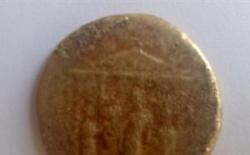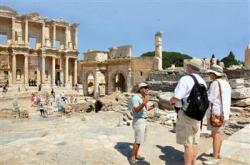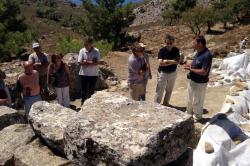INSTITUT SUPERIEUR D'ANTHROPOLOGIE
INSTITUTE OF ANTHROPOLOGY
ONLINE COURSES / COURS A DISTANCE
INSCRIPTION : Année Universitaire 2012/2013
REGISTRATION : Academic Year 2012 / 2013
CHYPRE –  - A significant archaeological finding, a gold coin, has been reported discovered underwater in the area between Limassol and Larnaca by a local amateur fisherman. According to Cypriot authorities, the coin is of great value. Cypriot media reported that it dates back to the first century A.D. and depicts the third Roman emperor called Caligula, well-known for his fierce and brutal policy during his reign. On this coin, Caligula is sacrificing an animal before the Temple of Augustus, which is constituted by six pillars. Many coins of the same age have been found over the course of time, but this one is regarded among the most significant because it’s made of gold. Representatives of the Nicosia Archaeological Museum of Cyprus stated that such a finding enriches cultural heritage of the broader region, and may provide archaeologists with important information on ancient Cyprus’ trade. Moreover, the area, where the golden coin was found, could reveal more clues concerning the coin’s origin and the way it ended up in Cyprus, they said.
- A significant archaeological finding, a gold coin, has been reported discovered underwater in the area between Limassol and Larnaca by a local amateur fisherman. According to Cypriot authorities, the coin is of great value. Cypriot media reported that it dates back to the first century A.D. and depicts the third Roman emperor called Caligula, well-known for his fierce and brutal policy during his reign. On this coin, Caligula is sacrificing an animal before the Temple of Augustus, which is constituted by six pillars. Many coins of the same age have been found over the course of time, but this one is regarded among the most significant because it’s made of gold. Representatives of the Nicosia Archaeological Museum of Cyprus stated that such a finding enriches cultural heritage of the broader region, and may provide archaeologists with important information on ancient Cyprus’ trade. Moreover, the area, where the golden coin was found, could reveal more clues concerning the coin’s origin and the way it ended up in Cyprus, they said.
http://eu.greekreporter.com/2012/08/21/emperor-caligula-gold-coin-found-underwater-near-cyprus/
TURQUIE –  Ephese - The ancient city of Ephesus, one of the premier tourist sites in Turkey readies to have a harbor on the Aegean coast again. Ephesus used to have a harbor on the Aegean coast, İzmir Culture and Tourism Provincial Director Abdülaziz Ediz recently told Anatolian news agency. The city’s importance as a commercial center declined as the harbor was slowly silted up by the Cayster River (Küçük Menderes). Ediz said they had been working to realize a project called “Ephesus Reunion with the Sea” with the support of the Culture and Tourism Ministry, as well as the Transportation, Maritime Affairs and Communications Ministry. Currently, the city’s distance is six kilometer to the sea. The city was famed for the Temple of Artemis (completed around 550 B.C.), one of the Seven Wonders of the Ancient World. Emperor Constantine I rebuilt much of the city and erected new public baths. Following the Edict of Thessalonica from emperor Theodosius I, the temple was destroyed in 401 A.D. by a mob led by St. John Chrysostom. The town was partially destroyed by an earthquake in 614 A.D. The city’s importance as a commercial center declined as the harbor was slowly silted up by the Cayster River (Küçük Menderes). Ephesus, which is today a UNESCO World Heritage Site, was one of the seven churches of Asia that are cited in the Book of Revelation, and the Gospel of John may have been written in the ancient city. The city was also the site of several fifth-century Christian councils.
Ephese - The ancient city of Ephesus, one of the premier tourist sites in Turkey readies to have a harbor on the Aegean coast again. Ephesus used to have a harbor on the Aegean coast, İzmir Culture and Tourism Provincial Director Abdülaziz Ediz recently told Anatolian news agency. The city’s importance as a commercial center declined as the harbor was slowly silted up by the Cayster River (Küçük Menderes). Ediz said they had been working to realize a project called “Ephesus Reunion with the Sea” with the support of the Culture and Tourism Ministry, as well as the Transportation, Maritime Affairs and Communications Ministry. Currently, the city’s distance is six kilometer to the sea. The city was famed for the Temple of Artemis (completed around 550 B.C.), one of the Seven Wonders of the Ancient World. Emperor Constantine I rebuilt much of the city and erected new public baths. Following the Edict of Thessalonica from emperor Theodosius I, the temple was destroyed in 401 A.D. by a mob led by St. John Chrysostom. The town was partially destroyed by an earthquake in 614 A.D. The city’s importance as a commercial center declined as the harbor was slowly silted up by the Cayster River (Küçük Menderes). Ephesus, which is today a UNESCO World Heritage Site, was one of the seven churches of Asia that are cited in the Book of Revelation, and the Gospel of John may have been written in the ancient city. The city was also the site of several fifth-century Christian councils.
http://www.hurriyetdailynews.com/ephesus-ancient-city-meets-sea-again.aspx?pageID=238&nID=28358&NewsCatID=375
UKRAINE – Lviv - Excavations will start in Arsenalna Square and part of a block in Staroievreiska Street of Lviv in early September, 2012. This area has been associated with the Jewish community life in Lviv, serving as a separate personal space for entire Jewish population of the city for centuries. The main research objective is discovering foundations of the Great City Synagogue and Beit ha-Midrash (prayer house-cum-library) which were destroyed during the World War II. The Jewish quarter of Lviv started its history in 1383. For centuries, a most diverse range of Jewish institutions functioned there, providing the community with its own cemetery, synagogue, ritual bath, hospital, girls’ school, etc. Almost all local residential houses are now listed as monuments. The Great City Synagogue, Beit ha-Midrash and the Turei Zahav (Golden Rose) Synagogue were the heart of this residential block (the latter building was completely looted in 1941 and blown up in 1943, with ceiling of the prayer hall collapsing and southern wall and gallery falling down; its Renaissance portal and part of the 18th century forged doors are still extant). The first two monuments were blown up by the Nazis in 1943, and the site has not been built up since.
http://www.day.kiev.ua/233801
ROYAUME UNI – Ipplepen - Excavation work has uncovered the remains of a round house, the type of houses lived in by native Britons during the Iron Age and unlike the Roman houses which were usually square. The presence of Roman pottery indicates that the round house was still used after the Romans arrived. The dig was triggered by a chance find of some coins by metal detectorist Philip Wills, of Torquay. He discovered a coin called a Denarius, currency that was minted in Rome and was probably brought to Britain by the Romans when they invaded in 43 AD. Geophysical surveys later uncovered evidence of an extensive settlement including roundhouses, quarry pits and track ways. Dr Oltean said: "It is not a Roman town, but a native village which may have been in existence before the Roman period. However, it traded actively with the Romans, shown by the initial collection of coins found and the ornate pottery, usually found near large cities and military camps and not in villages where most people would have used basic wooden bowls. "The uniqueness of this Romano-British settlement is shown in the level of coins and types of pottery found, indicating that an exchange in goods and money was happening in the area, on a much larger scale than known in other villages in Britain at this period of time." Miss Wootton said: "Previously there was little evidence of any Roman influence beyond the Roman city of Exeter. "What is interesting on the site is that, despite the presence of Roman pottery and coins, the inhabitants are still living in native roundhouses, as Britons had done for centuries before."
http://www.thisissouthdevon.co.uk/Village-pre-date-Romans-discovered-Ipplepen/story-16751509-detail/story.html
ITALIE – Riace - No further discoveries have been made after a search of the underwater area where an historic statue of a bronze lion was recently found off the southern Italian coast, authorities said Wednesday. Police divers found no trace of a sunken ship reportedly near where a bronze lion was discovered last week - and the same area that yielded the iconic Riace bronzes 40 years ago. All that was found was the radiator of a motorboat, said Simonetta Bonomi, superintendent for archaeological and cultural heritage of Calabria,.
http://www.ansa.it/web/notizie/rubriche/english/2012/08/22/-more-archaeological-finds-near-bronze-lion-_7367546.html
GRECE –  Anatoli - A Minoan mansion dating to 1600-1400 BC has been discovered in the mountainous area of Anatoli, Ierapetra, southeast Crete. The building, say archaeologists taking part in the excavation, appears to be undisturbed and indications are that its occupants fled after the building's destruction without taking any of the objects that were inside. The cause of destruction and the reasons for the building's abandonment have not yet been ascertained and further details are expected to emerge with the progress of the excavation. The building at Anatoli is the second to be excavated in Crete at such a high altitude. The only other example is found at Zominthos which was excavated by Yiannis and Efi Sakelaraki. Dr. Papadatos stressed that "the second objective is to begin to understand what happened at Ierapetra during Minoan times, for which we have little evidence." "Despite the varying importance of the Ierapetra Valley," Dr. Papadatos concludes, "we do not have the slightest idea of the location of the main Minoan settlement, nor do we know if there was some kind of administrative or palatial centre such as those that have been excavated in adjacent areas, like Gournia, Gialos and Myrtos. We are hopeful that the Anatoli building will help answer some of these questions."
Anatoli - A Minoan mansion dating to 1600-1400 BC has been discovered in the mountainous area of Anatoli, Ierapetra, southeast Crete. The building, say archaeologists taking part in the excavation, appears to be undisturbed and indications are that its occupants fled after the building's destruction without taking any of the objects that were inside. The cause of destruction and the reasons for the building's abandonment have not yet been ascertained and further details are expected to emerge with the progress of the excavation. The building at Anatoli is the second to be excavated in Crete at such a high altitude. The only other example is found at Zominthos which was excavated by Yiannis and Efi Sakelaraki. Dr. Papadatos stressed that "the second objective is to begin to understand what happened at Ierapetra during Minoan times, for which we have little evidence." "Despite the varying importance of the Ierapetra Valley," Dr. Papadatos concludes, "we do not have the slightest idea of the location of the main Minoan settlement, nor do we know if there was some kind of administrative or palatial centre such as those that have been excavated in adjacent areas, like Gournia, Gialos and Myrtos. We are hopeful that the Anatoli building will help answer some of these questions."
http://www.tovima.gr/